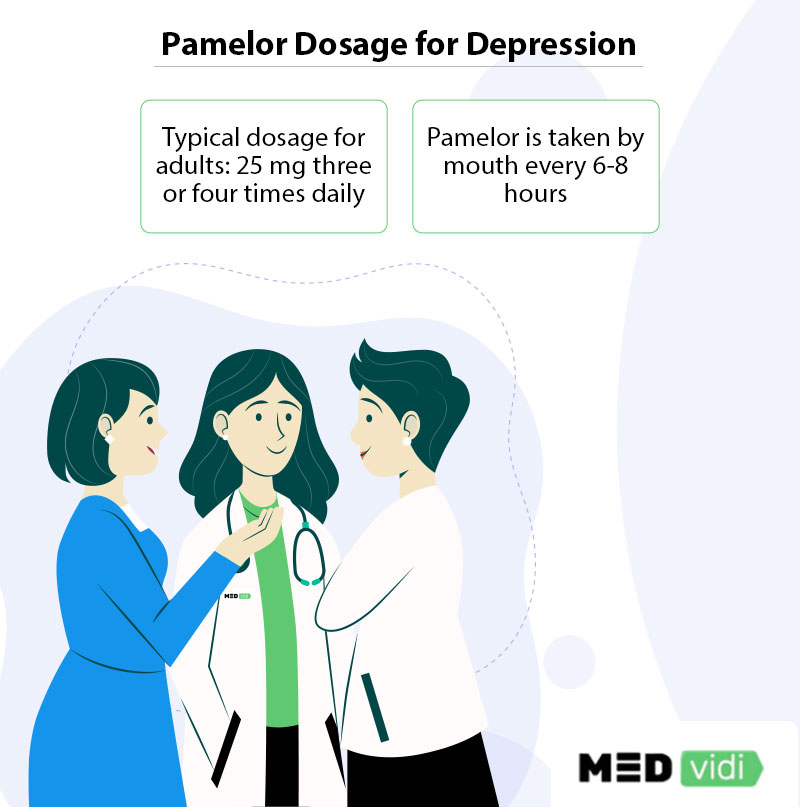Because of its characteristics resulting from the mechanism of action and drug class, Pamelor is not the first-line choice for depression treatment. Still, this drug has certain advantages. In this post, let’s explore the basic facts about it.
Ask a certified doctor if you need medication treatment for depression.
What Is Pamelor?
Pamelor’s generic name is nortriptyline. It is a tricyclic antidepressant used to
How to Use Pamelor
A patient must have an approved Pamelor prescription from a licensed health practitioner before starting to use Pamelor. Also, one should follow the doctor’s instructions for safe ingestion and use. Please note that the brand name Pamelor has been discontinued, but the medication is still available in generic forms.
The dosage significantly depends on a patient’s medical condition and treatment response. Most doctors recommend dividing the Pamelor dosage and taking 25 mg by mouth 1 to 4 times daily. If liquid, a patient should use a particular measuring device to measure the dose correctly. The maximum daily dose cannot exceed 150 mg. One must not skip any dose to get the most benefit from the medication.
What are the Side Effects of Using Pamelor?
The list of Pamelor’s side effects is extensive. The good thing is there are approaches to reducing the risks. For instance, the doctor will first prescribe low doses and gradually increase them.
The most common side effects are:
- Drowsiness
- Tiredness
- Weakness
- Vomiting
- Nausea
- Weight loss
- Constipation
- Unusual taste
- Dry mouth
- Sleep problems and insomnia
- Anxiety
- Changes in urination
- Excessive sweating
- Impotence
- Breast swelling
- Decreased sex drive
- Difficulty experiencing orgasm
One must contact a doctor immediately after observing some of the following serious side effects;
- Back muscle spasms
- A shuffling walk
- Rash
- Shakiness
- Fever
- Yellowish skin or eyes
- Irregular heart rate
- Suicidal thoughts
Here is how to manage some of these effects when under medication:
- Try to get up slowly to reduce the risk of lightheadedness and dizziness
- Keep yourself hydrated to relieve dry mouth
- Eat more dietary fiber and exercise to prevent constipation
Communicate with a doctor immediately after observing serious side effects like persistent heartburn, severe abdominal pain, and muscle spasms. Some studies show Pamelor can increase serotonin, risking serotonin syndrome.
It would help to understand that the doctor will only prescribe any medication, including Pamelor if its benefits for the patient outweigh the side effects it exposes one to.
Consult a doctor if you experience any side effects from antidepressants.
Pamelor for Migraines
A migraine is more than just a headache. It is a
Doctors ideally prescribe Pamelor for depression, but several

Warnings Before Taking Pamelor
Patients should take Pamelor only as prescribed by the doctor. It would help to note that antidepressant use among young patients can lead to suicidal thoughts. Also, avoid taking it if you:
- Are allergic to nortriptyline or similar medication
- Are allergic to seizure medications
- Recently experienced a heart attack
Is It Safe to Take Pamelor During Pregnancy?
Not many studies focus on solving the risks of women taking Pamelor during pregnancy. These studies found no evidence of an increased risk of congenital disabilities for pregnant patients. The only verified chance with a pregnant patient using Nortriptyline
Consult a doctor before taking Pamelor to avoid unwanted side effects.
Pamelor Interactions
Pamelor interacts with several medications, so you should consult your doctor and let them know all medications you are taking to avoid interactions and adverse effects. Products like arbutamine, thyroid supplements, disulfiram, and specific blood pressure drugs are examples of medicines that may interact with Pamelor. Avoid taking MAO inhibitors with this drug as it may result in a possibly fatal interaction. They include phenelzine, linezolid, metaxalone, rasagiline, tranylcypromine, and methylene blue.
Taking medication that increases serotonin levels in the body increases the risk of serotonin syndrome. They primarily include street psychiatric drugs like lithium and antidepressants like fluoxetine. Drugs treating irregular heart rates will affect the effectiveness of nortriptyline by facilitating its removal from the body.
Conclusion
Nortriptyline is a medication with several uses in the field of medicine. The medical practitioner might prescribe this antidepressant to treat depression and migraine. Following the doctor’s dosage and ingestion instructions is crucial to achieving the desired medical results and avoiding severe complications like side effects, withdrawal, or addiction. Contact MEDvidi doctors to know what medication will work best for you, and get prescription for depression online.













